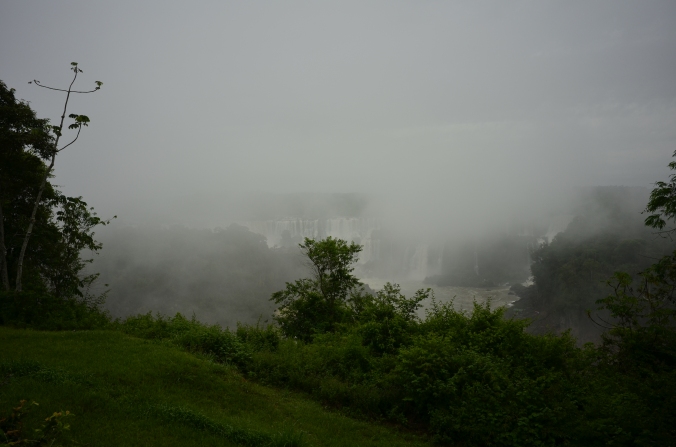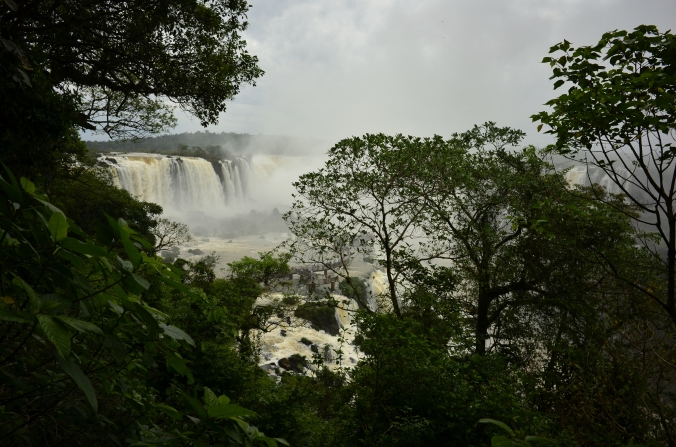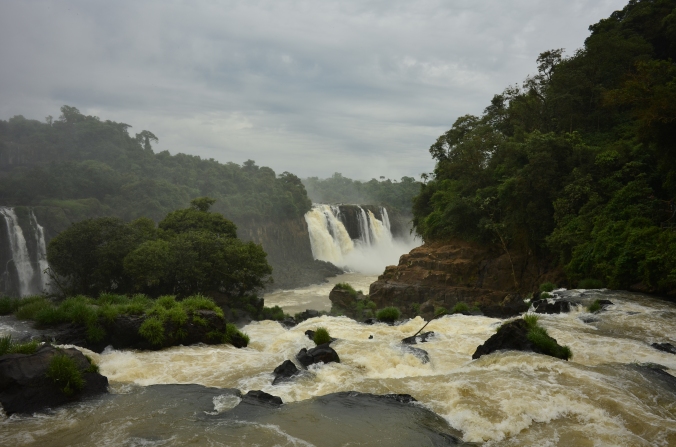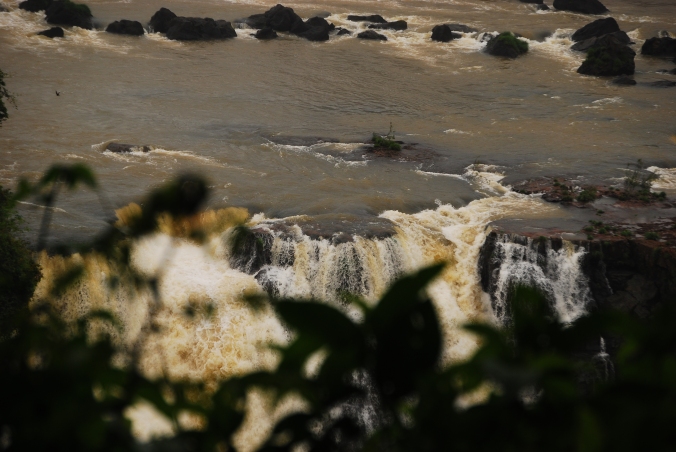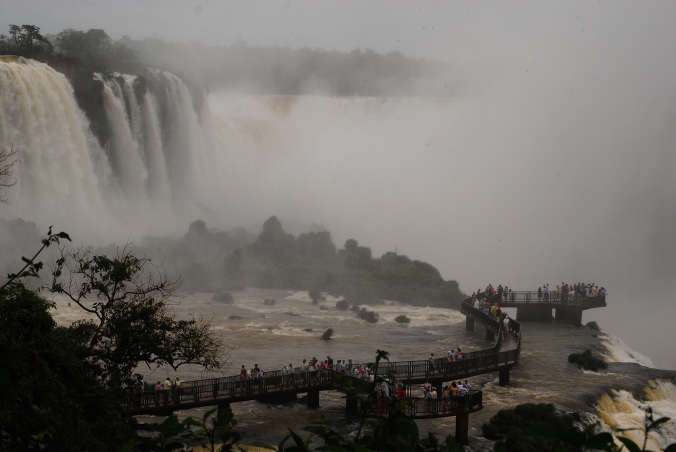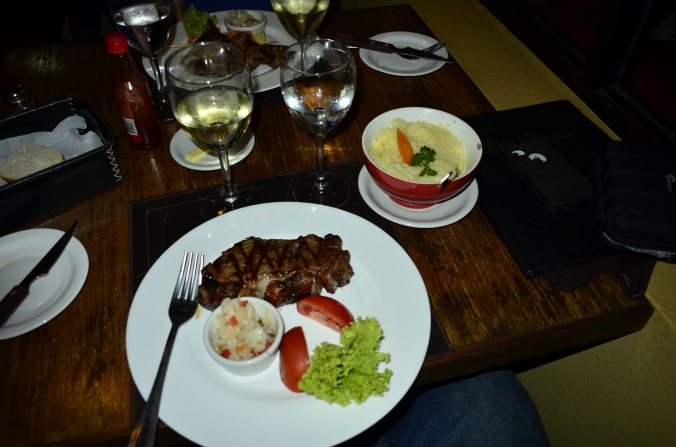We knew that a trip to the Falls wasn’t complete until you had seen it from both sides (Argentina AND Brazil). However, being US citizens, we needed a visa to get into Brazil. Thankfully, Puerto Iguazu in Argentina has a Brazilian consulate that grants quick visas.
Since the process is ever-changing (hello, South American official paperwork) and the information in the internet is slim, here’s our process. Fill out your Brazilian visa form online here, print out the form (and make sure you save a copy of your confirmation number!), and attach your approved passport photo. Remember–no smiling, needs to be a white background, and adhere strictly to the size limits. The online form is experimenting with uploading some documents, but it’s still in beta stage, and assume you’ll still need to bring your documents and paperwork with you. Also, when they ask for your hotel information in Brazil, we just chose a random hotel. They never checked to see if we actually had a reservation, and I assume most people coming through are day trippers.
If you’re a tourist: bring a copy of your driver’s license (front and back), a copy of your passport (including a copy of the page with your Argentinian entrance stamp), and a copy of your bank records proving sufficient funds. Also, we brought along a copy of our birth certificates, a copy of our marriage license, and, of course, our reciprocity fee papers. To be honest, the workers at the consulate just seemed impressed that we had all of our ducks in a row prior to coming in. (Insert some sort of grumbling about “if it was clear online, maybe there wouldn’t be that many problems” here.)
If you’re a temporary resident of Argentina: all of the above, PLUS a copy of your DNI (front and back), a copy of your residencia temporaria legal papers, and we brought along our precarias just to be safe. Also note, Argentine temporary residents–if you have your own car in Argentina, make sure with your car insurance company that it has the optional “MERCOSUR” insurance that allows it into Brazil. That is one thing that the Argentinian aduana was diligent in checking.
You can pay your fee, which is somewhere around the line of $160USD, in either pesos (subject to Brazil’s current feeling on what a peso is worth) or in reais. We paid in pesos and had absolutely no problem. Just be sure to have exact change (or as close as you can be. I think a 5 is okay if you have a bill that’s 32, but they won’t exchange 100 peso notes. If you need it, there’s a Macro bank in the city center of Puerto Iguazu, about four blocks away from the consulate, that has four clean, well-maintained ATMs. As usual in Argentina, stock in said ATMs will probably be lower around the 1st and 15th of every month as people get their government payouts on their EBTs. So plan accordingly.
So, we submitted all of our paperwork, paid all of our money, and left our passports with the nice Brazilians overnight and picked it up the next day. And, honestly? Although I had heard some stories about how the Brazilian consulate can be a madhouse of backpackers, tourists, and generally Americans behaving badly on a Friday–we were the only ones there besides the consulate employees. It was a pleasant experience, and not much of a hassle.
We have our own car down here in Argentina, and we double checked to make sure it has the optional MERCOSUR insurance upgrade that allows it to drive into any MERCOSUR country without a problem. There are plenty of buses in Puerto Iguazu that go to the falls everyday, and even more travel companies happy to take your money in exchange for a ride and a tour of the Brazilian side. We easily drove through customs (although we always get funny looks when the customs agent sees “EXTRANJERO” or foreigner printed on our national ID cards) and made it into Brazil.
Here’s where I talk about the seedy portion of all of this. The border between Argentina and Brazil at Iguazu/Iguacu is not terribly well patrolled for bus patrons. We’ve been told several times that it is absolutely easy for people to just ride a bus and go over to the other side without getting a visa, and without legally exiting/entering either Brazil or Argentina. Because we work down here, and we’d prefer to not have to call our employer for them to bail us out of the customs pokey, we chose to go the legal route, and thus, I have no comments about the whole “sneaking across the border” part of Iguazu.
In many ways, Foz de Iguacu is like Puerto Iguacu–all about the tourists. Shops and people selling their wares on the side of the road. And as always, poverty–the likes of which probably shocks those from the First World, but is sadly part of our landscape now. However, in many ways, the Brazilian side is radically different. Brazil has a much more open economy than Argentina. As a result, there are many more imported products–the motorcycles are Harleys and Hyabusas as opposed to bicycles that someone attached a lawnmower engine to. There’s Hershey’s chocolate and clothes from China. (In Argentina, one of the more draconian rules is that it’s incredibly difficult and expensive to import clothing for sale. As a result, easily 95% of the clothes are made in Argentina, with the exception of a few giants like Nike, Reebok, and LaCoste.) Everything just looks a little bit nicer, a little bit more commercial… a little bit more American. Whereas Puerto Iguazu feels exactly like an Argentinian/South American tourist town without any recognizable fast food brands or chains, Foz de Iguacu felt more like South America’s Myrtle Beach… with waterfalls!
This feel extended to the Foz de Iguacu park itself. With a modern parking lot (paved versus Argentina’s dirt), the ability to pay with a credit card (versus Argentina’s cash-only policy), and modern buses taking tourists from the fancy queues and gift shops to the actual falls (versus a train in Argentina… or a hike), it just felt more like an American Six Flags safari than Argentina’s side did. This is both good and bad. We loved the efficiency of just paying for parking when you bought your ticket, being able to easily use your credit card, clean public bathrooms, and obviously announcements in English, Spanish, and Portuguese. But it definitely felt less like a great South American adventure… and more like any other trip to an American tourist attraction.
However–the falls were beautiful! Whereas the Argentinian side lets you get up close and personal with the falls, the Brazilian side offers some great panoramic views. A concrete pathway winds along the side of the cliff–be careful, it’s much more crowded on the Brazilian side than we ever encountered in Argentina! But, you get some gorgeous photos of the Falls in their full glory–and they have a great concrete walkway that leads right into the mist of some of the falls–great for photo opportunities!
We grabbed lots of great photos, and saw even more coati trying to steal food from the tourists, but ultimately didn’t spend as much time on the Brazilian side. There are lots of side adventures run by private companies to partake in–zodiac boats, rock climbing, bike tours, white water rafting, ziplining–but the weather was starting to turn, and we didn’t feel like forking over $80 per person just to do a few little activities, most likely in the rain. Ultimately, we made the right decision: it was drizzling when we made it back to our car, and full-on pouring buckets of water by the time we made it to the border. We’re planning on coming back to Iguazu again before we leave South America–so we figured leave some of the fun activities for the next time!
We didn’t hang out in the town of Foz de Iguacu much this time–but there are definitely some nice-looking hotels and resorts in the area, if you’re looking to stay on that side. We did briefly try to follow the signs for the tres fronteras marker in Brazil, but ended up in a not-so-nice neighborhood bordering on a favela, or shantytown, and decided to call it quits on that.
If you’re in Iguazu, definitely go to the Brazil side if you have the time and visa! It’s worth it to get the panoramic views and to see just how different two countries can be, just on the other side of the border.
Since November 1st was our *real* anniversary (we got married in a courthouse before we got married in the “white dress and tux” sense), we decided to go to Bocamora in Puerto Iguazu for a celebratory dinner. Situated essentially on a cliff on the costanera, or coastline, it is an incredibly romantic location overlooking the Tres Fronteras area. The menu was diverse, as was the wine list, the service was great, and the view was incomparable. We enjoyed a really nice meal on their back patio and toasted to two years! T got the ojo de bife (a very nice cut of meat), and I got a pork loin, both of which were delicious. We aren’t normally “that couple” who takes pictures of their food, but it looked pretty spectacular, so we couldn’t help ourselves.
